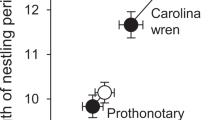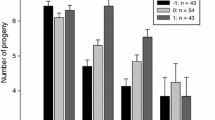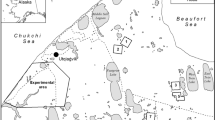Abstract
In birds, hatching failure is pervasive and incurs an energetic and reproductive cost to breeding individuals. The egg viability hypothesis posits that exposure to warm temperatures prior to incubation decreases viability of early laid eggs and predicts that females in warm environments minimize hatching failure by beginning incubation earlier in the laying period, laying smaller clutches, or both. However, beginning incubation prior to clutch completion may incur a cost by increasing hatching asynchrony and possibly brood reduction. We examined whether Florida scrub jays (Aphelocoma coerulescens) began incubation earlier relative to clutch completion when laying larger clutches or when ambient temperatures increased, and whether variation in incubation onset influenced subsequent patterns of hatching asynchrony and brood reduction. We compared these patterns between a suburban and wildland site because site-specific differences in hatching failure match a priori predictions of the egg viability hypothesis. Females at both sites began incubation earlier relative to clutch completion when laying larger clutches and as ambient temperatures increased. Incubation onset was correlated with patterns of hatching asynchrony at both sites; however, brood reduction increased only in the suburbs, where nestling food is limiting, and only during the late nestling period. Hatching asynchrony may be an unintended consequence of beginning incubation early to minimize hatching failure of early laid eggs. Food limitation in the suburbs appears to result in increased brood reduction in large clutches that hatch asynchronously. Therefore, site-specific rates of brood reduction may be a consequence of asynchronous hatching patterns that result from parental effort to minimize hatching failure in first-laid eggs. This illustrates how anthropogenic change, such as urbanization, can lead to loss of fitness when animals use behavioral strategies intended to maximize fitness in natural landscapes.





Similar content being viewed by others

References
Aldredge RA, LeClair SC, Bowman R (2012) Site-specific differences in hatching failure between suburban and wildland Florida scrub-jays. J Avian Biol 43:369–375. doi:10.1111/j.1600-048X.2012.05665.x
Arnold TW, Rohwer FC, Armstrong T (1987) Egg viability, nest predation, and the adaptive significance of clutch size in prairie ducks. Am Nat 130:643–653. doi:10.1086/284736
Beissinger SR, Cook MI, Arendt WJ (2005) The shelf life of bird eggs: testing egg viability using a tropical climate gradient. Ecology 86:2164–2175. doi:10.1890/04-1624
Bowman R (1998) Population dynamics, demography, and contributions to metapopulation dynamics by suburban populations of the Florida scrub-jay. Non-game wildlife technical report no. 11. Florida Game and Fresh Water Fish Commission, Tallahassee, FL
Bowman R, Woolfenden GE (2001) Nest success and the timing of nest failure of Florida scrub-jays in suburban and wildland habitats. In: Marzluff JM, Bowman R, Donnelly R (eds) Avian ecology and conservation in an urbanizing world. Kluwer, Norwell, pp 383–402
Bowman R, Woolfenden GE, Fitzpatrick JW (1998) Timing of breeding and clutch size in the Florida scrub-jay (Aphelocoma coerulescens). Ostrich 69:316–317
Clark AB, Wilson DS (1981) Avian breeding adaptations—hatching asynchrony, brood reduction, and nest failure. Q Rev Biol 56:253–277. doi:10.1086/412316
Cook MI, Beissinger SR, Toranzos GA, Rodriguez RA, Arendt WJ (2003) Trans-shell infection by pathogenic micro-organisms reduces the shelf life of non-incubated bird’s eggs: a constraint on the onset of incubation? Proc R Soc Lond B 270:2233–2240. doi:10.1098/rspb.2003.2508
Cooper CB, Hochachka WM, Butcher G, Dhondt AA (2005) Seasonal and latitudinal trends in clutch size: thermal constraints during laying and incubation. Ecology 86:2018–2031. doi:10.1890/03-8028
Fan HL, Sailor DJ (2005) Modeling the impacts of anthropogenic heating on the urban climate of Philadelphia: a comparison of implementation in two PBL schemes. Atmos Environ 39:73–84. doi:10.1016/j.atmosenv.2004.09.031
Fieberg J, Rieger RH, Zicus MC, Schildcrout JS (2009) Regression modeling of correlated data in ecology: subject-specific and population averaged response patterns. J Appl Ecol 46:1018–1025. doi:10.1111/j.1365-2664.2009.01692.x
Fleischer TL, Woolfenden GE (2004) Florida scrub-jays eject foreign eggs added to their nests. J Field Ornithol 75:49–50
Forbes S, Glassey B, Thornton S, Earle L (2001) The secondary adjustment of clutch size in red-winged blackbirds (Agelaius phoeniceus). Behav Ecol Sociobiol 50:37–44. doi:10.1007/s002650100332
Hébert P (2002) Ecological factors affecting initiation of incubation behaviour. In: Deeming DC (ed) Avian incubation: behaviour, environment, and evolution. Oxford University Press, New York, pp 271–279
Klomp H (1970) The determination of clutch size in birds. A review. Ardea 58:1–124
Koenig WD (1982) Ecological and social factors affecting hatchability of eggs. Auk 99:526–536
Lack D (1954) The natural regulation of animal numbers. Oxford University Press, New York
Lack D (1968) Ecological adaptations for breeding in birds. Methuen, London
McMaster DG, Sealy SG (1999) Do brown-headed cowbird hatchlings alter adult yellow warbler behavior during the hatching period? J Field Ornithol 70:365–373
Moreno-Rueda G, Soler M, Soler JJ, Martinez JG, Perez-Contreras T (2007) Rules of food allocation between nestlings of the black-billed magpie Pica pica, a species showing brood reduction. Ardeola 54:15–25
Mumme RL (1992) Do helpers increase reproductive success? Behav Ecol Sociobiol 31:319–328
Rensel MA, Wilcoxen TE, Schoech SJ (2011) Corticosterone, brood size, and hatch order in free-living Florida scrub-jay (Aphelocoma coerulescens) nestlings. Gen Comp Endocrinol 171:197–202. doi:10.1016/j.ygcen.2011.01.011
Schoech SJ, Mumme RL, Moore MC (1991) Reproductive endocrinology and mechanisms of breeding inhibition in cooperatively breeding Florida scrub jays (Aphelocoma c. coerulescens). Condor 93:354–364. doi:10.2307/1368951
Schoech SJ, Mumme RL, Wingfield JC (1996) Delayed breeding in the cooperatively breeding Florida scrub-jay (Aphelocoma coerulescens): inhibition or the absence of stimulation? Behav Ecol Sociobiol 39:77–90. doi:10.1007/s002650050269
Shawkey MD, Bowman R, Woolfenden GE (2004) Why is brood reduction in Florida scrub-jays higher in suburban than in wildland habitats? Can J Zool 82:1427–1435. doi:10.1139/Z04-123
Stoleson SH, Beissinger SR (1995) Hatching asynchrony and the onset of incubation in birds revisited: when is the critical period? Curr Ornithol 12:191–271
Stoleson SH, Beissinger SR (1997) Hatching asynchrony, brood reduction, and food limitation in a Neotropical parrot. Ecol Monogr 67:131–154. doi:10.1890/0012-9615(1997)067[0131:HABRAF]2.0.CO;2
Stoleson SH, Beissinger SR (1999) Egg viability as a constraint on hatching asynchrony at high ambient temperatures. J Anim Ecol 68:951–962. doi:10.1046/j.1365-2656.1999.00342.x
Valkama J, Korpimäki E, Holm A, Hakkarainen H (2002) Hatching asynchrony and brood reduction in Tengmalm’s owl Aegolius funereus: the role of temporal and spatial variation in food abundance. Oecologia 133:334–341. doi:10.1007/s00442-002-1033-2
Wang JM, Beissinger SR (2009) Variation in the onset of incubation and its influence on avian hatching success and asynchrony. Anim Behav 78:601–613. doi:10.1016/j.anbehav.2009.05.022
Wang JM, Firestone MK, Beissinger SR (2011) Microbial and environmental effects on avian egg viability: do tropical mechanisms act in a temperate environment? Ecology 92:1137–1145
Woolfenden GE (1978) Growth and survival of young Florida scrub jays. Wilson Bull 90:1–18
Woolfenden GE, Fitzpatrick JW (1984) The Florida scrub jay: demography of a cooperative-breeding bird. Princeton University Press, New Jersey
Woolfenden GE, Fitzpatrick JW (1996) Florida scrub-jay (Aphelocoma coerulescens). In: Poole A, Gill F (eds) The birds of North America, no. 228. The Academy of Natural Sciences, Philadelphia, The American Ornithologists’ Union, Washington, DC, pp 1–28
Acknowledgments
We thank Laura Kearns, Sonya LeClair, April Feswick, and Angela Tringali for field work assistance in the suburban site and the staff at Archbold Biological Station for logistical support during the study. We thank the students, staff and faculty at the University of Memphis for collecting data in the wildland site, especially Travis Wilcoxen and Gina Morgan. We thank one anonymous reviewer and S. R. Beissinger for helpful comments on the manuscript. Financial support was provided by the American Ornithologists’ Union and the University of Central Florida. The long-term monitoring of suburban and wildland Florida scrub jays that allowed this work was supported by National Science Foundation awards to R. B. (IBN-03406328) and S. J. S. (IOS-0346328).
Author information
Authors and Affiliations
Corresponding author
Additional information
Communicated by Indrikis Krams.
Rights and permissions
About this article
Cite this article
Aldredge, R.A., Boughton, R.K., Rensel, M.A. et al. Hatching asynchrony that maintains egg viability also reduces brood reduction in a subtropical bird. Oecologia 174, 77–85 (2014). https://doi.org/10.1007/s00442-013-2749-x
Received:
Accepted:
Published:
Issue Date:
DOI: https://doi.org/10.1007/s00442-013-2749-x



